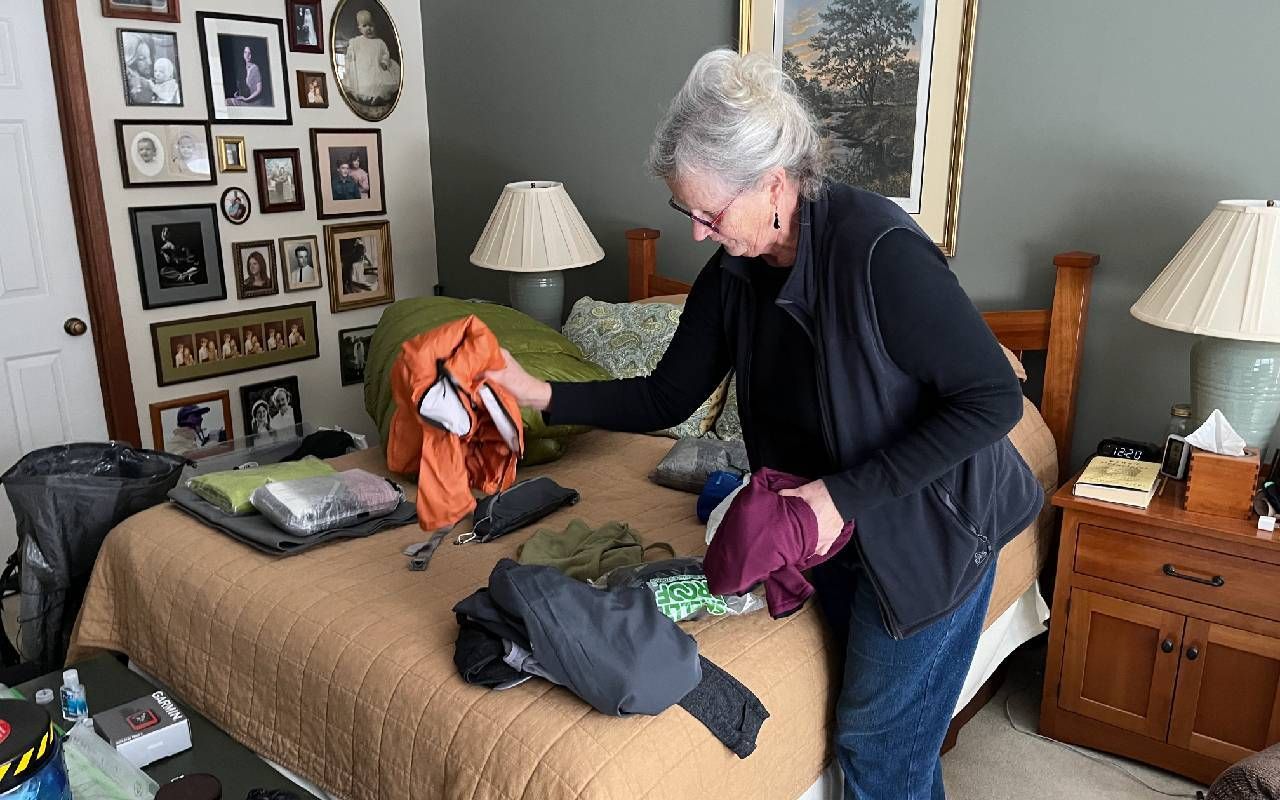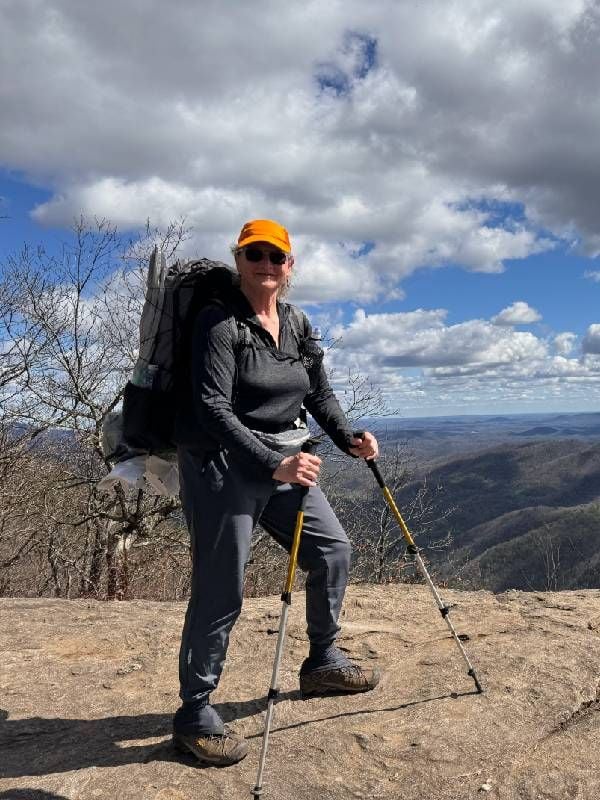Contemplating a 2,000-Mile Stroll in the Woods
What one 70-something hiker learned about taking on late-life challenges
When Jeanette Rice announced that she was taking on the Appalachian Trail at age 73, no one in her family was truly surprised. Rice is a lifelong adventurer. She once rode her bike from Seattle to Baltimore and spent several of her early retirement years sailing with her husband, Bill, from Nova Scotia to the Caribbean.

Still, as Bill Bryson's 1998 best-seller "A Walk in the Woods," will testify, hiking the "A.T.," as it's known in shorthand, is no walk in the park. It's a grueling 2,197-mile trek that starts west of Athens, Georgia, winding north through 14 states, and culminating in a climb up the 5,268-ft. Mt. Katahdin in central Maine.
Rice had been mulling the possibility of trekking the A.T. since 1992, when she discovered some trail guides in a book shop. "It was like the clouds opened up," she vividly recalls. "The sun came out, the spirits came down and said, 'You are supposed to do this.' And I said, 'Yeah, I'm supposed to do this.' And I'm running outta time because I'll be 74 when I'm on the trail."
In Record Territory
Rice is not the first septuagenarian to take on the A.T. but turning 74 along the way, a successful thru-hike — completing the trail end-to-end within a year — would require Rice to tie the current age record for a woman, set by Nan "Drag'n Fly" Reisinger, who finished the trek in 2014.
The average A.T. thru-hiker is 37, but most who complete the trail are in their 20s. In 1955, Emma "Grandma" Gatewood became the first woman to solo the A.T. when she was 67. Last year, Pamela Clark, 76, of Florida managed to cover the entire trail, though with some forced interruptions. According to the Appalachian Trail Conservancy, which keeps the official tally, Clark's achievement does not technically qualify as a thru-hike, as it took longer than 12 months to complete.
"I don't think anybody could talk me out of this. I shared it with Bill and we generally don't tell each other what to do."
Once Rice made up her mind and began setting dates, she initially kept her plans from most of her family and friends. "I just didn't want to hear a lot of questions," she explains. "I don't think anybody could talk me out of this. I shared it with Bill and we generally don't tell each other what to do," she laughs.
Rice trained doggedly for months by briskly walking the back roads near her home in the Helderberg Hills of upstate New York. But soon after she departed from the trail's southern terminus in the Chattahoochee National Forest, Rice began to encounter some challenges of her own. She found that water could be hard to come by along the trail, and she was pummeled by some severe weather.
Both are growing concerns along the A.T. as the climate becomes more chaotic. Generally speaking, the northern reaches are getting wetter and subject to more frequent washouts, while the southern section is drying out and seeing more wildfires.
An Unlikely Encounter
Then, about 54 miles from the starting line, atop Rocky Mountain, she was stung by a bee. It startled her because at altitude in early March, it seemed too chilly for that to be a worry. But in Rice's case it's always a worry because she's "deathly allergic" to bee stings. "Oh, it'll kill me," she says.
"All of a sudden, zap – behind my left thigh or left calf. And really, I'm like, 'No,' she laughs in retrospect. "And then my lips started swelling and I started getting itchy."

She did a deep dive into her pack for one of two epinephrine injectors or "epi-pens" she had brought along and jabbed herself in the thigh to stave off any life-threatening effects – but she was mildly rattled by having to use one of the pens so soon into her trip.
In spite of it all, Rice says she was on Cloud Nine, churning up five to 12 miles a day. "I loved it," she recalls, with still reverberating bliss. "I was so happy. I felt so peaceful. I was doing great. I enjoyed every day. I didn't have any aches or pains. Nothing hurt. I felt like I was getting stronger."
A Worrisome Tech Glitch
Initially Rice's husband, Bill, seven years her senior, had taken the whole idea in stride (so to speak). But after he bid farewell to his wife, he began to worry. At one point her GPS device sent Bill an errant ping, showing her well off the trail. She says he began frantically checking in to see if she was all right.
"The last two days I was on the trail, he seemed to be in such a frenzy with texts and phone calls that he ran my battery down," recalls Jeanette. Bill's angst was understandable. In their 55 years of marriage, the two had never been separated for more than about six weeks and this outing was estimated to take six months.
As the worries and stress mounted for Bill and the rest of the Rice family, they began to weigh more heavily on Jeanette. She came to realize there was more at stake than her own pride, more to consider than her own physical and mental preparedness for what they all expected to be a months-long trek. Finally, barely 80 miles into it, Rice made the tortured decision to head home.

"I sobbed unmercifully before I made the decision to come home to him," she recalls. "I didn't want to get off trail."
The Irresistible Challenge
The A.T.'s magnetism is legendary. According to Ann Simonelli at the Appalachian Trail Conservancy, 3 million to 4 million people leave their footprints on it in a typical year, but just a little more than 1,400 earned their "2000-Miler" certificates in 2022 (which was a big year and the most recent one with complete data, as people are still reporting in from 2023).
"A thru-hike for many people definitely relies on community and others to help keep the thru-hikers going," says Simonelli. But who supports the support group back home?
"I don't know if it's a cautionary tale," says Rice on reflection. "It's a tale of how relationships evolve. And I think we have to continue to be cognizant of each other's positions and feelings."
But the itch is still there to be scratched. "I can't seem to shake the need to do this," says Rice.
"If I'm still vertical next spring, I fully intend to start again. I'm supposed to do this. I'm supposed to learn something, and I don't know what it is."
When she first came off the trail, Rice seemed resigned to becoming a "segment hiker," taking on the world's longest continuous footpath a piece at a time. But after only a few weeks at home, she was once again determined – not just to finish the trail – but to start again at the beginning and thru-hike the whole thing. Maybe next year.
"If I'm still vertical next spring, I fully intend to start again," she now insists. "I'm supposed to do this. I'm supposed to learn something and I don't know what it is."
One thing she's learning is patience. She draws on some centuries-old wisdom from Sun Tzu's "The Art of War": "Those who are victorious plan effectively and change decisively. They are like a great river that maintains its course but adjusts its flow."
"That's how I will be successful," says Rice. "And I'm hoping that I'll find renewed hope and a renewed purpose when I come back."
Advice for Later-in-Life Hikers
Tempted to take on the A.T. as an older adult? Here are some tips gathered from various sources by the Appalachian Trail Conservancy:
- Prepare your body
- Do lots of walking, then practice hiking on trails carrying a pack similar in weight to a thru-hike pack (33.9 pounds).
- Exercise to improve flexibility, side-to-side stability and strength in your knees, quadriceps, core and upper body.
- Listen to your body
- Take a "zero day" (a day off the trail to rest) at least once every two weeks.
- Limit yourself to 8-12 miles a day for the first few weeks to give your body time to adjust to the rigors of day-in, day-out hiking.
- Connect with past A.T. thru-hikers of similar ages and demographics
- The ATC maintains “affinity lists” of people who have recently completed hiking all or much of the A.T. and are willing to share their advice.
- The lists – including an over-55 group – are available by e-mail ing [email protected].
More tips and resources are available in the Conservancy's Hiker Resource Library.

Read More

